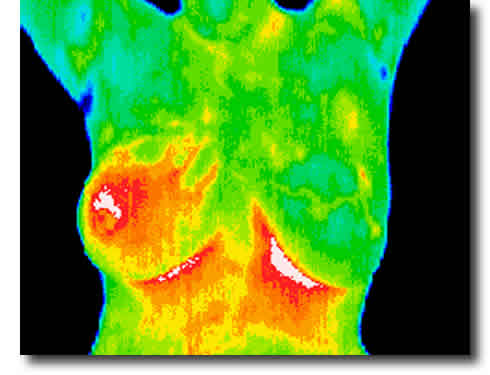Thermography
- Home
- Thermography
Overview of Digital Infrared Thermal Imaging
Medical DITI is a noninvasive adjunctive diagnostic technique that allows the examiner to visualise and quantify changes in skin surface temperature. An infrared scanning device is used to convert infrared radiation emitted from the skin surface into electrical impulses that are visualised in colour on a monitor. This visual image graphically maps the body temperature and is referred to as a thermogram. The spectrum of colours indicate an increase or decrease in the amount of infrared radiation being emitted from the body surface. Since there is a high degree of thermal symmetry in the normal body, subtle abnormal temperature asymmetry’s can be easily identified.
Medical DITI’s major clinical value is in its high sensitivity to pathology in the vascular, muscular, neural and skeletal systems and as such can contribute to the pathogenesis and diagnosis made by the clinician.
Medical DITI has been used extensively in human medicine in the U.S.A., Europe and Asia for the past 20 years. Until now, cumbersome equipment has hampered its diagnostic and economic viability. Current state of the art PC based IR technology designed specifically for clinical application has changed all this.
Clinical uses for DITI include;
- To define the extent of a lesion of which a diagnosis has previously been made;
- To localise an abnormal area not previously identified, so further diagnostic tests can be performed;
- To detect early lesions before they are clinically evident;
- To monitor the healing process before the patient is returned to work or training.
Skin blood flow is under the control of the sympathetic nervous system. In normal people there is a symmetrical dermal pattern which is consistent and reproducible for any individual. This is recorded in precise detail with a temperature sensitivity of 0.01°C by DITI.
The neuro-thermography application of DITI measures the somatic component of the sympathetic nervous system by assessing dermal blood flow. The sympathetic nervous system is stimulated at the same anatomical location as its sensory counterpart and produces a ‘somato sympathetic response’. The somato sympathetic response appears on DITI as a localised area of altered temperature with specific features for each anatomical lesion.
The mean temperature differential in peripheral nerve injury is 1.5°C. In sympathetic dysfunction’s (RSD / SMP / CRPS) temperature differentials ranging from 1° C to 10° C depending on severity are not uncommon. Rheumatological processes generally appear as ‘hot areas’ with increased temperature patterns. The pathology is generally an inflammatory process, i.e. synovitis of joints and tendon sheaths, epicondylitis, capsular and muscle injuries, etc.
Both hot and cold responses may co exist if the pain associated with an inflammatory focus excites an increase in sympathetic activity. Also, vascular conditions are readily demonstrated by DITI including Raynauds, Vasculitis, Limb Ischemia, DVT, etc.
Medical DITI is filling the gap in clinical diagnosis …
- X ray, C.T. Ultrasound and M.R.I. etc., are tests of anatomy.
- E.M.G. is a test of motor physiology.
- DITI is unique in its capability to show physiological change and metabolic processes. It has also proven to be a very useful complementary procedure to other diagnostic modalities.
Unlike most diagnostic modalities DITI is non invasive. It is a very sensitive and reliable means of graphically mapping and displaying skin surface temperature. With DITI you can diagnosis, evaluate, monitor and document a large number of injuries and conditions, including soft tissue injuries and sensory/autonomic nerve fibre dysfunction.
Medical DITI can offer considerable financial savings by avoiding the need for more expensive investigations.
Medical DITI can graphically display the very subjective feeling of pain by objectively displaying the changes in skin surface temperature that accompany pain states.
Medical DITI can show a combined effect of the autonomic nervous system and the vascular system, down to capillary dysfunctions. The effects of these changes show as asymmetry’s in temperature distribution on the surface of the body.
Medical DITI is a monitor of thermal abnormalities present in a number of diseases and physical injuries. It is used as an aid for diagnosis and prognosis, as well as therapy follow up and rehabilitation monitoring, within clinical fields that include Rheumatology, neurology, physiotherapy, sports medicine, oncology, pediatrics, orthopedics and many others.
Results obtained with medical DITI systems are totally objective and show excellent correlation with other diagnostic tests.
For more information please visit meditherm.com or call Rita Sloan at 770-846-6286 to schedule an appointment.


